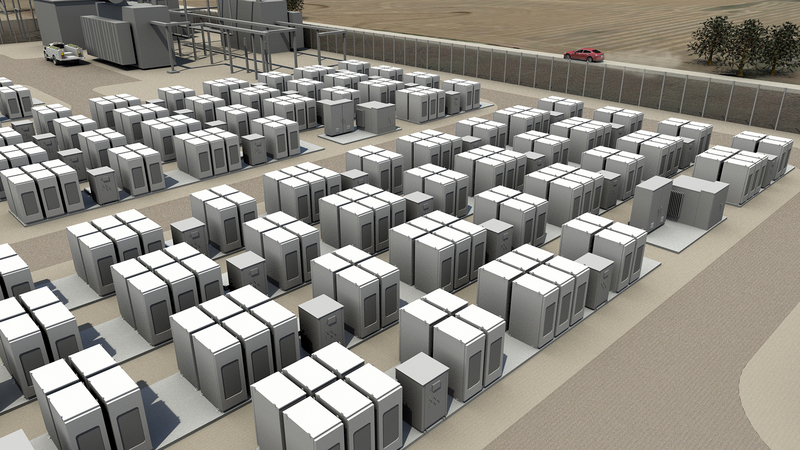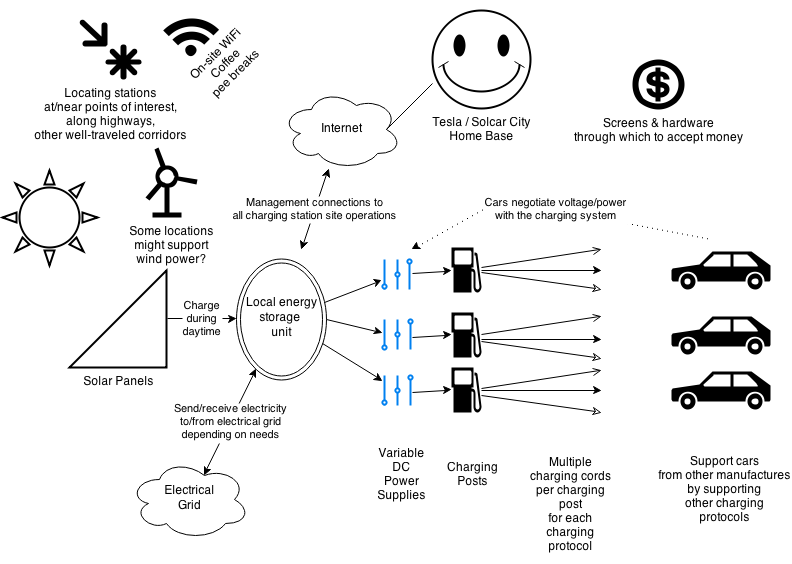Tonight Tesla Motors announced what we’ve expected, but it’s a bigger deal than expected. Specifically, Tesla Motors is launching what’s essentially a new business unit, Tesla Energy, and positioning itself not as an automaker but as an “energy innovation company”. Tesla Energy’s product line is, initially, grid-tied energy storage units that integrate with solar panels and also allow time-shifting of electricity to capture cheap night-time electricity for consumption during the day. The result is that Tesla Energy customers can form what’s called “energy islands” where a house or building or neighborhood can operate mostly or completely independently from the electricity grid with no loss of modern convenience.
As has often been the case with Elon Musk, he positioned this as “we must do this” because of the carbon impacts currently underway in the atmosphere. At the beginning of the presentation he showed a slide with the current “business-as-usual” pattern of global energy use and the impact on atmospheric carbon, noting that we’re heading to carbon levels that have never been seen on this planet (according to the fossil record).
We can’t continue on this path, and Elon said the only solution he’d (his team) had come up with was the product Tesla Energy is now offering. Namely:
- To rely on sunlight — this fusion reactor in the sky that produces a tremendous amount of energy
- Grid energy storage systems to make captured sunlight a viable solution.
There are two well known problems to capturing sunlight (via solar panels or otherwise)
- Sun doesn’t always shine – how to power society at night?
- Existing grid energy storage (batteries) suck – here he has to be referring to lead-acid grid energy storage systems, because there are other companies like Tesla that are developing lithium-ion based grid energy storage systems
The solution, according to Elon Musk, is a grid energy storage system that can freely take solar panel energy, and grid energy, based on need. It enables storage of solar power, and enables buying cheap electricity at night for release during the day. By storing solar power a house can run off solar even at night. By time-shifting electricity consumption, it means that night-time-generated electricity no longer has to go to waste.
At the scale of the entire U.S.A. our entire electricity consumption could be satisfied with a solar panel array the size of the Texas Panhandle. The grid energy storage array required would be a barely detectable smidgeon of that land area. But we don’t have to pave the Panhandle to do this, we just install the solar panels on every suitable rooftop, and the energy storage systems bolted to the side of the building or at substations or whatnot.
In addition to making renewable solar energy practical such a system has huge money-saving potential. Just the opportunity to buy cheap electricity at night to avoid buying expensive day-time electricity is a huge win.
What Elon Musk claimed is that the missing component in the market (until now) has been a single-source solution for grid-solar-tied energy storage systems. Tesla Energy is, according to Musk, the first to offer such a solution. He might be right, I haven’t surveyed that market to be certain, because while there are several companies offering large scale lithium-ion grid energy storage systems (and other sorts of energy storage), perhaps none of them are offering a single source solution. It may be that with all other suppliers, the customer has to cobble together a solution with parts from several vendors?
Tesla Energy has a range of products lined up, the first of which is ready to go on sale in 3-4 months.
It’s called the Powerwall, and is a 10 kiloWatt-Hour battery pack that ties to both solar panels and the grid. It stores electricity from either source, and can supply the house and/or EV charging station. It seamlessly shifts energy around based on current conditions. It enables load shifting – buying electricity at cheap night-time rates for use during the day. It acts as backup power in case of power outage.
The Powerwall mounts, as expected, on the wall, and is safe for mounting on outside walls. It can be scaled up to 9 units for 90 kiloWatt-hours total.
The installers price (excluding inverter and installation) is $3500.
In a separate announcement, Solar City said![]() “Using Tesla’s suite of batteries for homes and businesses, SolarCity’s fully-installed battery and solar system costs are one-third of what they were a year ago.” That’s big – a huge drop in price means it’ll become a no-brainer to adopt this technology.
“Using Tesla’s suite of batteries for homes and businesses, SolarCity’s fully-installed battery and solar system costs are one-third of what they were a year ago.” That’s big – a huge drop in price means it’ll become a no-brainer to adopt this technology.
At this low a price, how quickly would energy cost savings pay for the system?
But, wait, that’s not all. They’ve also developed another unit meant for commercial scale installations. There are two levels for this product.
- Businesses — e.g. Amazon.com has plenty of server farms and a commitment to running them on 100% renewable electricity. The company see’s Tesla Energy products as a way to do so.
- Grid scale energy storage, such as at a substation or larger facility. Mentioned in the press kit is Southern California Edison, a utility company in Southern California which has contracts in place to add over 250 megawatt-hours of energy storage capacity to their facilities.
One of the uses this commercial unit will see is in Tesla’s own Supercharger network. Elon didn’t mention this tonight, but had previously announced that in the due course of time the Supercharger installations would combine solar panels and local grid energy storage sized big enough that each Supercharger location can (if needed) keep running after the Zombie Apocalypse.
During the announcement, Elon gave a huge hint of something – that the Gigafactory will be operational during 2016 and delivering these products. The initial production will come out of the Fremont factory, but he said that beginning next year (2016) the Powerwall and other products would come from the Gigafactory.
Finally, he pointed out that there will be multiple Gigafactories over the due course of time. I’ve written about this previously, with back-of-the-napkin calculations suggesting Tesla will need 10+ Gigafactories by 2025. It’s simply a matter of production capacity. Tesla Motors hopes to be building millions of cars a year by 2025, so pencil out the battery pack production capacity requirements and it turns into several Gigafactories. Add a significant quantity of Tesla Energy product sales and that’s even more need for multiple Gigafactories.
If all this sounds familiar then you’ve got a good memory for some of my previous postings. I’ve written previously about exactly this kind of product, pointing at Tesla as a likely provider. Honda has a research home in Davis CA with many of the same principles, demonstrating Tesla isn’t the only company barking up this tree. Coda Energy, the remaining remnant of the Coda Automotive disaster, is also working on grid energy storage systems.
- Is there enough Grid Capacity for Hydrogen Fuel Cell or Battery Electric cars? - April 23, 2023
- Is Tesla finagling to grab federal NEVI dollars for Supercharger network? - November 15, 2022
- Tesla announces the North American Charging Standard charging connector - November 11, 2022
- Lightning Motorcycles adopts Silicon battery, 5 minute charge time gives 135 miles range - November 9, 2022
- Tesla Autopilot under US Dept of Transportation scrutiny - June 13, 2022
- Spectacular CNG bus fire misrepresented as EV bus fire - April 21, 2022
- Moldova, Ukraine, Georgia, Russia, and the European Energy Crisis - December 21, 2021
- Li-Bridge leading the USA across lithium battery chasm - October 29, 2021
- USA increasing domestic lithium battery research and manufacturing - October 28, 2021
- Electrify America building USA/Canada-wide EV charging network - October 27, 2021






















Pingback: The 200+ mile range $35k EV competition, is Tesla still out in front? | The Long Tail Pipe
Pingback: Grid energy storage key to Clean Power Plan success, not its downfall | The Long Tail Pipe